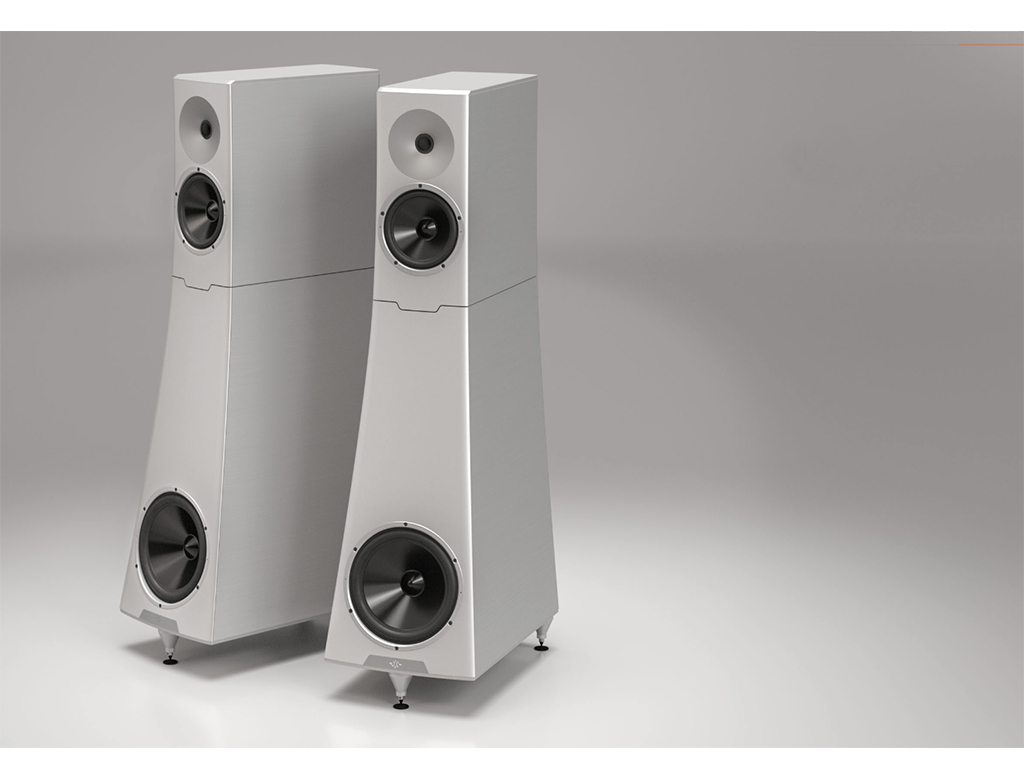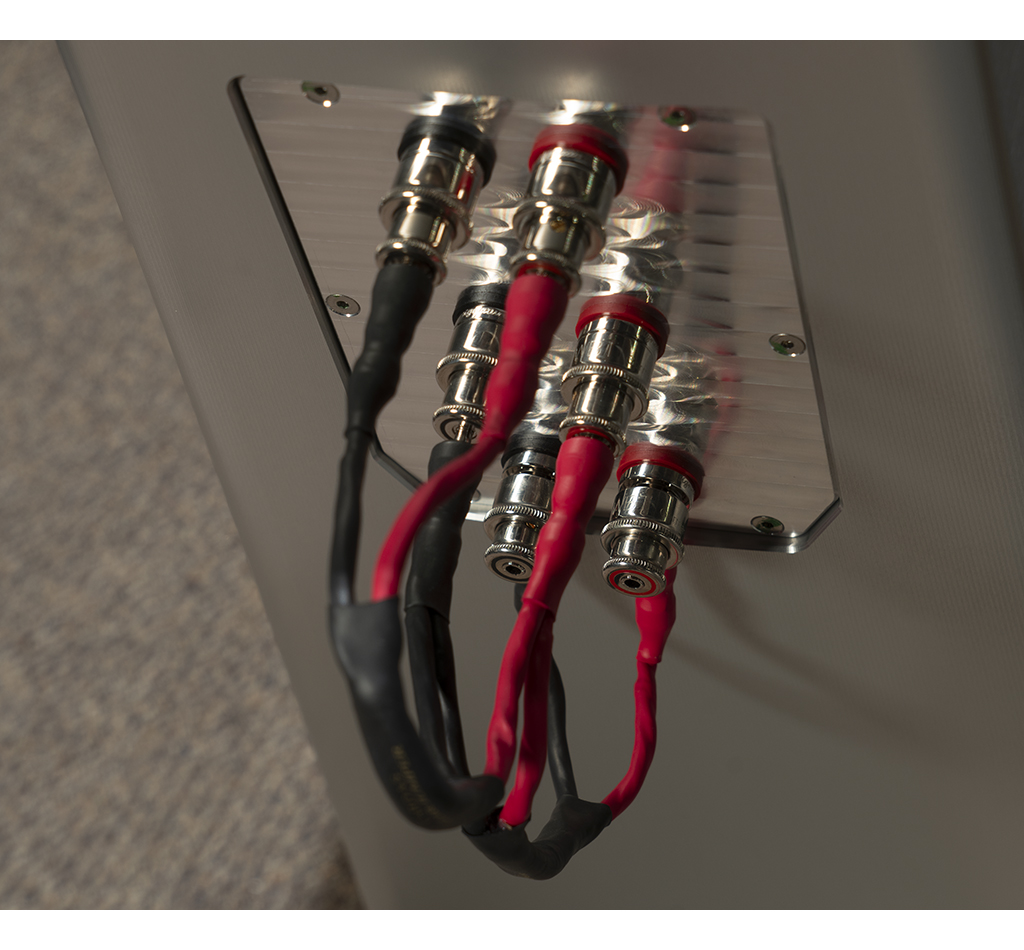
Listening to the gentle guitar and drum work in J.J. Cale’s “Magnolia” instantly reveals the level of resolution that the PlatiMon Virtual Coaxial One speakers can serve up. Driven by the BAT REX tube power amplifier, this is a lovely match – delivering speed, tonal saturation and a huge soundfield in all three dimensions. (Photo courtesy of MON Acoustic)
Don’t be thrown off by the pair of 5-inch woofers, these small-ish speakers, with their dual ports around back generate serious bass energy. The pair of small drivers makes for quick, detailed and resolute bass that is more than quick enough to keep up with the AMT style tweeter in the middle of the two drivers.
Switching it up to the more blistering rendition of “Magnolia” by Pat Travers and giving the volume control a firm twist confirms that these speakers rock. They deliver more than enough sound pressure (in a 24 x 36 foot room) with ease to satisfy all but the most brutal metalheads. Thanks to their 91dB/1-watt sensitivity, you won’t need a ton of power to play music as loud as you need. They do a fantastic job at filling this substantial room volume, though I’d probably suggest a pair of subs, if you’re living on a constant diet of techno, hip hop, and prog music with a lot of low frequency content way down deep. Claimed frequency response is 44Hz to 30,000Hz.
Good news – MON has a pair of bass cabinets (much like the Watt/Puppy) on the way called the VC Two, and we will have a pair to review as soon as they are available. While designer Jun Hyeog Seo travels his own path, it’s clear there are a few design influences at work with the PlatiMon speakers. (Mr. Seo has been inspired by the best examples of the speaker art.) For now, to get a feel for what that might sound like, I tried them with a pair of REL S/510 subwoofers with excellent result. So, we anxiously await the bass cabinets, which will eliminate the need for the stands as well.
Unbox and setup
Everything is straightforward. You’ll instantly notice upon unpacking how much care has gone into the construction of these speakers. The metalwork and evenness of the anodizing is as good as it gets. If I didn’t know better, I’d swear that these speakers came from YG or Magico.
Starting with the speakers about ten feet from the room’s side walls and about six feet from the rear wall gives a clearer picture of the overall sound, albeit less bass reinforcement. Again, the Platimons have an ESL-like transparency with a massive sound extending well beyond the speaker boundaries. Listening to David Sylvian’s spacy Gone to Earth and Thomas Dolby’s The Flat Earth feels more like going for a swim than merely listening to music.
Because of the bass extension that these speakers provide, when moving them inside to the 12 x 18-foot living room environment, they were placed a little further in than normal on both axis. If you are living in a small to medium sized room, you should be able to make good use of room gain to get solid bass output in the sub-40hZ range with ease. In my smallest 11 x 14-foot room, the Platimon’s in a nearfield configuration had me questioning if I really need a separate headphone rig!
Unique stands
The speakers themselves are machined from aluminum, with enclosures in silver or black anodized as you see in our review samples. Matching stands of the same material are included so you achieve the optimum tweeter to floor height, and leaving nothing to chance. Byun takes speaker to stand interface a step further in that the speaker and stands each have an inverted dimple so you can use the supplied ball bearings to float the speakers on their stands, or use another material to achieve a different tonality.
Your level of audiophile inquisitiveness will determine how far you take this. (Wait for it…) Yes, I couldn’t stand it, so I tried several different things between the speakers and stands with varied properties. I even tried a set of small Super Balls from Amazon. Incidentally, this was my second favorite option.
Like all the filter choices on my dCS Vivaldi, I always end up going back to the factory settings, and the same can be said for the PlatiMon speakers. The supplied ball bearings still offered the best all-around combination of tight bass, excellent lower to mid bass transition and overall speed. Mind you, these are subtle changes, not OMG, there’s a UFO landing in the backyard changes. Those of you that love to fine tune will be in your element. This makes the fun aspect of the PlatiMons high, because the ability to fine tune is so easy.
More listening
Going through a wide range of program material is a joyous experience. All of the choices that have gone into the final design of the PlatiMon speakers combine to offer a highly seamless musical experience. Coupling an AMT tweeter to other drivers is always a tough task, and very few manufacturers pull it off to the extent that is achieved here. Not saying this lightly, during the review these speakers were compared to the Borg 2 and Kim from FinkTeam, two pairs of MartinLogan Motion speakers and even a pair of original ESS AMT-1b speakers in my garage system.
Female vocal lovers will appreciate the smoothness of the tweeter, yet listening to male vocals gives a better example of the crossover’s ability to blend HF and LF. Johnny Cash, or Bob Dylan’s voice are a great way to hear plenty of musical output from both drivers, and if the timing is off, or there’s a huge discrepancy in power response, their voices will not have the huskiness, body, and weight they are known for. I’m sure you probably have a few of your own favorites to try this with.
The PlatiMons deliver an excellent sense of timing and musical pace. When at Chris’ house the other night listening to his setup of the new Skyanalog REF cartridge, the same thing was going on with his reference system when we listened to Kind of Blue. All of the instruments were blended as they should be, yet all occupied their own space without being buried under one another. It’s one of those deceptively simple aspects of musical reproduction that sometimes you don’t even notice until it’s wrong.
These speakers always present a lack of blur in musical transients and high frequency decay. Cymbals and percussion sound natural, along with stringed instruments. Some of the metal cabinet speakers auditioned here have exhibited a great sense of dynamic energy yet impart their own sense of tonality to the music being presented. The PlatiMon speakers do not fall victim to this. Listening to them for days on end is an exceptionally pleasant experience. So much so, that I did purchase the review samples to use as an ongoing reference.
Final thoughts
Listening started with the BAT REX power amplifier, but a number of different solid-state and tube amplifiers were auditioned in the weeks leading up to this review. With such a neutral tonal balance on tap, the PlatiMons will take you in the tonal direction of your amplification – you won’t have to worry about getting a bit too much of a good thing, regardless of what amplification you have on hand.
They also prove easy to drive, even with lower powered amplifiers. The BAT is big and dynamic, yet our reference ampsandsound Bryce monoblocks delivered the most delicate listening experience, with layer upon layer of inner detail. Should you purchase a pair of these, you will be surprised at how far you can keep upgrading equipment and still hear more musical information – these speakers are that good. The recently reviewed Enleum AMP-23R is a very close second place.
The highest compliment I can give the PlatiMon Virtual Coaxial One speakers (besides purchasing them) is that they make no missteps at all. How many products can you say that about? When listening, I never have that awful audiophile dialog running in my head, thinking “if only they did more of this,” or “if only they didn’t do that.”
My true hope for these speakers is that they can help introduce a wider range of music enthusiasts to high performance audio, unencumbered by the reputation of some of the long standing speaker companies that have completely lost their way in terms of pricing products that almost no one can afford.
They meet every requirement for one of our Exceptional Value Awards. Very enthusiastically recommended, and #toneaudioapproved as well. These are staying as a permanent reference speaker.
$6,000/pair without stands
*8,000/pair with stands included
monacoustic.us
NOTE: Because of a mishap with UPS, we received a pair of Sanctus F1 Signature speaker cables, instead of the beginning. As MON uses this wire inside the Virtual Coaxial One, they are a perfect match. The results of adding them to the system will be in issue 122 of TONE, included with this review and more photos!


















